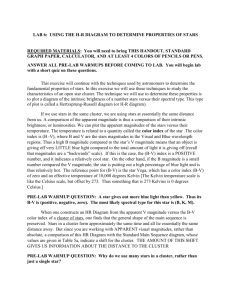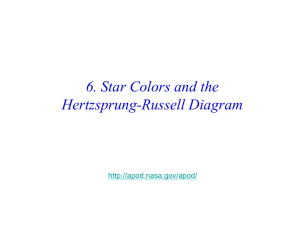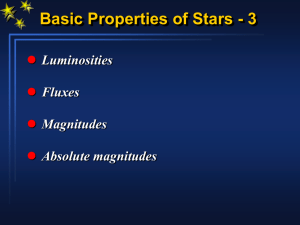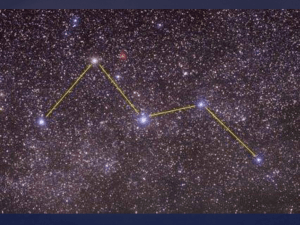Goal: To understand the HR diagram
advertisement
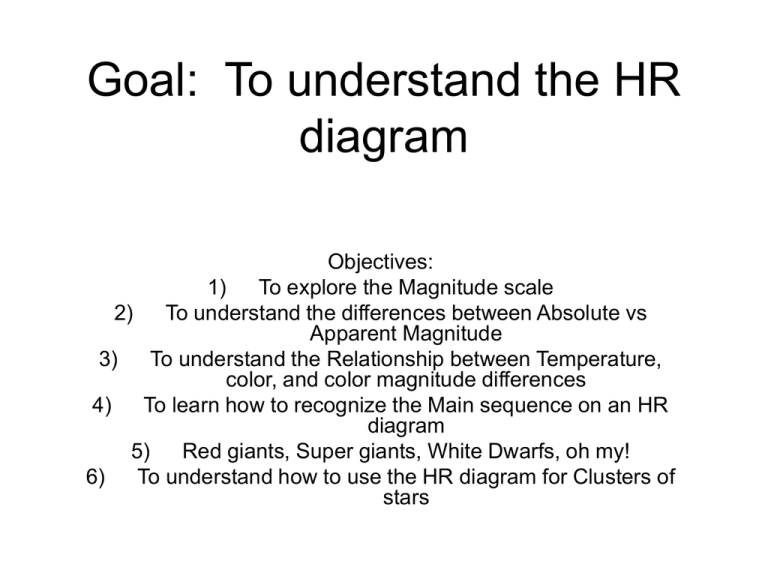
Goal: To understand the HR diagram Objectives: 1) To explore the Magnitude scale 2) To understand the differences between Absolute vs Apparent Magnitude 3) To understand the Relationship between Temperature, color, and color magnitude differences 4) To learn how to recognize the Main sequence on an HR diagram 5) Red giants, Super giants, White Dwarfs, oh my! 6) To understand how to use the HR diagram for Clusters of stars Magnitude scale • magnitude scale allows us to compare stars of vastly (a factor of a trillion) different brightnesses on a single scale. • Bigger numbers mean dimmer, smaller brighter. • Each “color” has its own scale – and all are calibrated to Vega. Apparent Magnitude • • • • The most common Observed The brightness as viewed from Earth The apparent Magnitude of our sun from Earth is -26 • The brightest star in the sky Sirius is about a -1 • The dimmest star you can see in country with naked eye is about a 7 or 8. Absolute Magnitude • • • • Mv Based on Absolute brightness That is the actual power of the object. Mv is what the star would appear to be if it was a distance of 10 Parsec away. • The Absolute Magnitude of our sun is about +5 Magnitudes of a different color • What happens if you compare magnitudes of different colors? • You get the temperature of the object! • You also get the COLOR of the object. • How? Brightness via the black body • (draw Blackbody spectrum on board). • At different temperatures, the blackbody spectrum peaks out at a different part of the spectrum. • Hot stars peak in the blue – so they appear to be blue. • Moderate stars peak in the middle, so appear to be yellow to white. • Cooler stars peak in the red, so appear to be orange to red. Color vs. color • What happens if I were to compare the magnitudes of two different colors? Suppose I took the Blue color magnitude (B) and subtracted the brightness magnitude in the middle of the visual spectrum (V). • For a hot star, will this value (B-V) be value be positive or negative? B-V vs. color • For a hot star, this value is NEGATIVE! • Reason, brighter means LOWER magnitude. • The object is blue, so the B will be lower than the V. • Will B-V increase or decrease as the temperature of a star decreases? B-V vs. temperature • As the temperature drops, the B value drops. • Meanwhile the V value does not change much. • Therefore B-V increases as temperatures drop. • In fact, a B-V value is the indicator of a specific temperature of star! Color vs. temperature • Since the color of a star depends on temperature, it turns out that Color, temperature, and B-V are ALL connected! • But wait, there’s MORE! Main sequence stars • Ask you this again… • Over the course of its lifetime, how much do the color and brightness of a main sequence star change? • A) not much (maybe by 0.3 magnitudes) • B) moderate amount (0.5-1 magnitude) • C) considerable amount (2-3 magnitudes) • D) they go all over the place (> 4 magnitudes) What determines the absolute brightness (and therefore temperature) of a main sequence star? • • • • A) its age B) its distance from us C) its mass D) its spin rate Therefore: • Any position on the Main Sequence has a one to one relationship with the mass, brightness, and color of the star. • So, you can plot the Main Sequence as a line on a chart which compares the brightness to the color/temperature/color magnitude difference of ANY star! HR Diagram • HR Diagram is a log-log plot. • It plots brightness (either absolute or apparent) vs. color or temperature or B-V. http://outreach .atnf.csiro.au/e ducation/senio r/astrophysics/ stellarevolutio n_hrintro.html Clusters of stars • Stars form in clusters. • If we plotted all the stars from a single cluster what might we get? • First we should ask 2 questions: • 1) How do the distances from us compare to all the stars in the cluster (close to same, or not close)? • 2) How do the ages of the stars in the cluster compare? http://www.sh ef.ac.uk/physi cs/teaching/p hy103/hrclust er.html • • • • This is a VERY young cluster! All the stars are main sequence stars. As the cluster ages, the biggest stars peel off (like peeling layers of an onion) and die. So, this chart evolves with time. AGE! • If you know the age of the stars that are starting to die, you know the age of the cluster! • This point I called the “turn off point”. • This cluster does not have a turn off point, which is very rare. Distance • You can also find the distance to this cluster. • First, lets figure out what our sun would look like if it were in this cluster. • From the earth the B-V of the sun is 0.68. • Will that change with distance? Distance • B changes, and V change. • With distance each get bigger (bigger = dimmer). • However, they change by the same amount, so B-V is a CONSTANT! • Therefore, we just need to compare V to the absolute magnitude of a star to find the distance! Distance • If the sun was in this cluster, what would it’s V value be? • B-V from Earth is 0.68. Distance from magnitude shift • A shift in magnitude gives us a factor. • The square root of this factor gives us the factor in distance (since light spreads out over the radius squared). • Since magnitudes are logarithmic, the equation is an exponential. • To do this, find the V of the sun in the cluster. • The absolute magnitude of the sun is +5.0. • Find the difference between the two and call this X (so X = V of sun if in cluster – 5.0) • Distance = 10 parsecs * 10X/5 For Pleiades • Vsun would be about 10. • So X = 10-5 • X=5 D = 10 pc * 10(X/5) D = 10 pc * 10(5/5) • D = 100 parsec Conclusion • On the main sequence you have a 1 to 1 relationship between color and mass. • Color = B-V = temperature • Since the top left stars on the main sequence die first the top left is always peeling off of the main sequence. • The position where there is turn off tells you the age of the cluster • The comparison of absolute to apparent magnitudes tells you the distance to the cluster.
